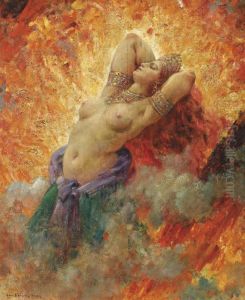Leon Beroud Paintings
Leon Beroud was a French painter born on April 17, 1858, in Lyon, France. He was known for his historical and genre paintings, as well as for being a skilled muralist. Beroud's artistic journey began at the Ecole des Beaux-Arts de Lyon, where he initially trained before moving to Paris to further his studies at the Ecole des Beaux-Arts under the tutelage of renowned painters like Jean-Leon Gerome and Alexander Cabanel.
Beroud's work was heavily influenced by the academic art tradition, which emphasized classical standards of beauty, drawing, and realistic representation. He developed a particular interest in historical and allegorical subjects, which was a popular genre during the 19th century. His paintings often depicted scenes from history with an emphasis on realism and attention to detail, which earned him recognition in his time.
The artist exhibited his works at the Salon, the official art exhibition of the Académie des Beaux-Arts in Paris. His paintings garnered positive reviews, and he was awarded medals at the Salons of 1880 and 1889. Beroud's reputation as a muralist was solidified through his contributions to public buildings and churches, where his frescoes can still be admired. These works further demonstrated his ability to handle large-scale compositions with a sense of grandeur and drama.
Throughout his career, Leon Beroud's dedication to the academic style meant that he remained relatively conservative in his approach to painting, even as the art world around him began to embrace modernism. Despite the shifting artistic landscape, his works continued to be appreciated for their technical proficiency and historical significance.
Leon Beroud passed away on January 3, 1927, in Paris. Although he may not be as widely recognized today as some of his contemporaries, his contributions to the academic tradition and his role as a muralist have ensured that he remains a respected figure among those who study 19th-century French art. His works continue to be studied and appreciated for their historical value and mastery of traditional painting techniques.
